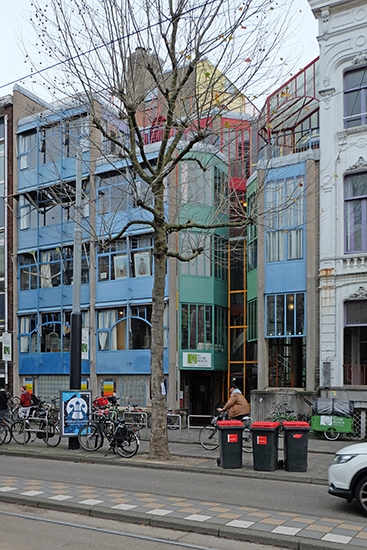 |
 |
 |
 |

Hubertushuis
Plantage Middenlaan 33, Amsterdam
1973 - 1978
On
behalf of the charitable Hubertusvereinigung Aldo van Eyck designed the
mothers' house, which was intended as a place to go and
as an accommodation for single mothers with their children. They were
offered temporary living quarters and support. The design of the
Hubertushuis was elaborated in close contact with the association. The
complex provides space for 16 mothers and up to 78 children. The new
six-storey building with the
colorful facade should appear welcoming and cheerful, and forms an
ensemble together with the
adjacent neo-baroque building. On the one hand, the
new façade fits into the existing street line with regard to its height
and structure; on the other hand, the facade stands out clearly because
of its color. Inside, the cheerful and child-friendly design continues
with rainbow colors. The entrance and the staircase are recessed
from the street front. The layout of the entrance and the stairwell
articulates two buildings, consisting of a tall and entirely new block
as well as a lower extension to the existing construction. Colour and
materials are used as unifying elements. Changing floor plans with
various stairways,
terraces, passageways and glazed walls give the building a friendly and
bright atmosphere. With his design, Aldo van Eyck intended to stimulate
human coexistence and social contacts. The parents' sleeping and living
quarters as well as the staffrooms are to be found in the existing
premises. Within the all-new block are contained a canteen with
kitchen, storage spaces and a day nursery for children aged one to six.
The two top stories, high up and isolated, are reserved for the babies.
Located at an inner court, a low-rise volume contains dwelling units
expanding over two floors. Each unit consists of a bedroom, living room
with veranda, kitchen, toilet and washroom, housing up to ten children.
The building structure consists of a constant concrete frame made of
columns and floor slabs with a core containing the elevator and
toilets. Most of the non-loadbearing walls are glazed to make sure the
space remains easy to read.
Im Auftrag der karitativen Hubertusvereinigung entwarf Aldo van Eyck das Mütterhaus, welches als Anlaufstelle und Unterkunft für alleinerziehende Mütter mit ihren Kindern gedacht war. Diese konnten hier Wohnen und Unterstützung in Anspruch nehmen. Der Entwurf für das Hubertushuis wurde in engem Kontakt mit der Vereinigung entwickelt. Der Komplex biete Platz für 16 Mütter und bis zu 78 Kinder. Der sechsstöckige Neubau mit der farbenfrohen Fassade sollte einladend und fröhlich wirken, und bildet zusammen mit dem benachbarten neobarocken Gebäude ein Ensemble. Einerseits fügt sich die neue Fassade hinsichtlich ihrer Höhe und Gliederung in die bestehende Strassenzeile ein, andererseits sticht die Fassade aufgrund ihrer Farbigkeit deutlich hervor. Im Inneren setzt sich die fröhliche und kindergerechte Gestaltung mit den Regenbogenfarben fort. Der Eingang und das Treppenhaus sind von der Strassenfront zurückgezogen. Die Anordnung und Gestaltung von Eingang und Treppenhaus artikulieren zwei Gebäude, einen hohen und komplett neuen Block und einen niedrigeren Anbau an das bestehende Gebäude. Farben und Materialität werden dabei als verbindende Elemente eingesetzt. Abwechslungsreiche Grundrisse mit verschiedenen Treppen, Terrassen, Durchgängen und und verglasten Wänden verleihen dem Gebäude eine heitere und helle Atmosphäre. Mit seinem Entwurf wollte Aldo van Eyck ausdrücklich das menschliche Miteinander und die sozialen Kontakte fördern. Die Schlaf- und Wohnräume der Mütter sowie die administrativen Räume befinden sich im Altbau. Im Neubau befinden sich eine Kantine mit Küche, Lagerräume und ein Hort für Kinder im Alter von eins bis sechs Jahren. Die beiden obersten Stockwerke sind den Neugeborenen vorbehalten. An einem Innenhof gelegen enthält der niedrige Gebäudeflügel Wohneinheiten auf zwei Geschossen. Jede Einheit bietet bis zu zehn Kindern Platz und besteht aus einem Schlafraum, Wohnraum mit Veranda, Küche, Toilette und Washraum. Eine regelmässige Stützen / Platten Struktur bildet die Statik des Gebäudes, mit einem Kern bestehend aus Nasszellen und Aufzug. Die meisten nichttragenden Wände sind verglast, so dass der Raum einfach lesbar bleibt.
Im Auftrag der karitativen Hubertusvereinigung entwarf Aldo van Eyck das Mütterhaus, welches als Anlaufstelle und Unterkunft für alleinerziehende Mütter mit ihren Kindern gedacht war. Diese konnten hier Wohnen und Unterstützung in Anspruch nehmen. Der Entwurf für das Hubertushuis wurde in engem Kontakt mit der Vereinigung entwickelt. Der Komplex biete Platz für 16 Mütter und bis zu 78 Kinder. Der sechsstöckige Neubau mit der farbenfrohen Fassade sollte einladend und fröhlich wirken, und bildet zusammen mit dem benachbarten neobarocken Gebäude ein Ensemble. Einerseits fügt sich die neue Fassade hinsichtlich ihrer Höhe und Gliederung in die bestehende Strassenzeile ein, andererseits sticht die Fassade aufgrund ihrer Farbigkeit deutlich hervor. Im Inneren setzt sich die fröhliche und kindergerechte Gestaltung mit den Regenbogenfarben fort. Der Eingang und das Treppenhaus sind von der Strassenfront zurückgezogen. Die Anordnung und Gestaltung von Eingang und Treppenhaus artikulieren zwei Gebäude, einen hohen und komplett neuen Block und einen niedrigeren Anbau an das bestehende Gebäude. Farben und Materialität werden dabei als verbindende Elemente eingesetzt. Abwechslungsreiche Grundrisse mit verschiedenen Treppen, Terrassen, Durchgängen und und verglasten Wänden verleihen dem Gebäude eine heitere und helle Atmosphäre. Mit seinem Entwurf wollte Aldo van Eyck ausdrücklich das menschliche Miteinander und die sozialen Kontakte fördern. Die Schlaf- und Wohnräume der Mütter sowie die administrativen Räume befinden sich im Altbau. Im Neubau befinden sich eine Kantine mit Küche, Lagerräume und ein Hort für Kinder im Alter von eins bis sechs Jahren. Die beiden obersten Stockwerke sind den Neugeborenen vorbehalten. An einem Innenhof gelegen enthält der niedrige Gebäudeflügel Wohneinheiten auf zwei Geschossen. Jede Einheit bietet bis zu zehn Kindern Platz und besteht aus einem Schlafraum, Wohnraum mit Veranda, Küche, Toilette und Washraum. Eine regelmässige Stützen / Platten Struktur bildet die Statik des Gebäudes, mit einem Kern bestehend aus Nasszellen und Aufzug. Die meisten nichttragenden Wände sind verglast, so dass der Raum einfach lesbar bleibt.
